Articles
- Page Path
- HOME > J Korean Acad Nurs > Volume 40(2); 2010 > Article
-
Original Article
- Geriatric Foot Problems and Related Factors in Two Provinces of Korea
- Shinmi Kim, Jaehong Ahn, Sookhee Choi, Yunjung Lee
-
Journal of Korean Academy of Nursing 2010;40(2):161-171.
DOI: https://doi.org/10.4040/jkan.2010.40.2.161
Published online: April 30, 2010
1Associate Professor, Department of Nursing, Changwon National University, Changwon, Korea.
2Director, DoctorGood Rehabilitation Clinic, Daegu, Korea.
3Professor, Department of Psychology, Woosuk University, Wanju, Korea.
4Associate Professor, Department of Nursing, Woosuk University, Wanju, Korea.
- Address reprint requests to: Lee, Yunjung. Department of Nursing, Woosuk University, 333 Samrye-ro, Samrye-eup, Wanju 565-701, Korea. Tel: 82-63-290-1544, Fax: 82-63-290-1548, yjlee@woosuk.ac.kr
• Received: January 22, 2009 • Revised: February 2, 2009 • Accepted: November 27, 2009
Copyright © 2010 Korean Society of Nursing Science
Abstract
-
Purpose
- The purpose of the study was to identify the prevalence, risk factors and clinical meanings of geriatric foot problems and to suggest implications for the future.
-
Methods
- One hundred eighty nine elderly aged 60 and over from institution as well as community were investigated for their foot conditions by means of a questionnaire including general characteristics, self care capacity, risk factors, foot problem checklist, X-ray, podoscopy and foot scan. Descriptive statistics and χ2-test was performed as appropriate utilizing SPSS version 14. Less than .05 of p-value was adopted as statistical significance level.
-
Results
- All subjects had at least one kind of foot problem and the most prevalent ones were nail problems, foot deformities in order. Prevalence of foot pain and edema was relatively low.
-
Conclusion
- Foot problem in elderly is prevalent and geriatric foot is expected to emerge as one of the most important problems in the geriatric field. Therefore strategies to deal with geriatric foot should be developed and practiced for better quality of life in later life.
- 1. Bowman MC. O'Connor PL, Schaller TM. Nerve problems, heel pain and other hindfoot conditions. In: Footworks II. 2001;Portage, MI, Patrick L. O'Connor. 107–130.
- 2. Burzykowski T, Molenberghs G, Abeck D, Haneke E, Hay R, Katsambas A, et al. High prevalence of foot diseases in Europe: Results of the Achilles Project. Mycoses. 2003;46(11-12):496–505.ArticlePubMedPDF
- 3. Chaiwanichsiri D, Janchai S, Tantisiriwat N. Foot disorders and falls in older persons. Gerontology. 2009;55:296–302.ArticlePubMedPDF
- 4. Chan MK, Chong LY. A prospective epidemiologic survey on the prevalence of foot disease in Hong Kong. Journal of the American Podiatric Medical Association. 2002;92:450–456.ArticlePubMed
- 5. Dunn JE, Link CL, Felson DT, Crincoli MG, Keysor JJ, McKinlay JB. Prevalence of foot and ankle conditions in a multiethic community sample of older adults. American Journal of Epidemiology. 2004;159:491–498.ArticlePubMed
- 6. Frey CC. Sammarco GJ. Osteoarthritis and static deformity of the forefoot. In: Foot an ankle manual. 1991;Philadelphia, PA, Lea & Febiger. 136–144.
- 7. Helfand AE. Foot problems in older patients: A focused podogeriatric assessment study in ambulatory care. Journal of the American Podiatric Medical Association. 2004;94:293–304.PubMed
- 8. Hijmans JM, Geertzen JH, Schokker B, Postema K. Development of vibrating insoles. International Journal of Rehabilitation Research. 2007;30:343–345.ArticlePubMed
- 9. InterRAI Overview Committee. RAI-Home Care (RAI-HC) Assessment manual of version 2.0. 1999;Washington, InterRAI Corporation.
- 10. Jung S, Lee S. A study on anthropometric measurement and type classification of foot for the elderly. Journal of Korean Society Design Science. 2001;14:95–105.
- 11. Katsambas A, Abeck D, Haneke E, van de Kerkhof P, Burzykowski T, Molenberghs G, et al. The effects of foot disease on quality of life: Results of the Achilles Project. Journal of the European Academy of Dermatology and Venereology. 2005;19:191–195.ArticlePubMed
- 12. Kim G. A study on the shape of women's foot arches. 2001;Seoul, Kyunghee University. Unpublished doctoral dissertation.
- 13. Kim T. A study of foot types and deformities of adults in a rural community in Korea. 1996;Seoul, Hanyang University. Unpublished master's thesis.
- 14. Lee YM. Effect of self foot reflexology massage on depression, stress responses and immune functions of middle aged women. Journal of Korean Academy of Nursing. 2006;36:179–188.ArticlePubMedPDF
- 15. Menz HB, Morris ME, Lord SR. Footwear characteristics and risk of indoor and outdoor falls in older people. Gerontology. 2006;52:174–180.ArticlePubMedPDF
- 16. Merck Source ®. 2008, October 24. Medical dictionary. from http://www.mercksource.com. Retrieved at January, 14, 2009.
- 17. Ministry for Health, Welfare and Family Affairs. Elderly Policy: Long term care insurance for elderly. 2008;from http://www.mw.go.kr. Retrieved at July 03, 2008.
- 18. Moon SK, Shin YM, Park SH, Shin DH, Choi JS, Kim KH. Prevalence of tinea pedis and onychomychosis in the aged. Korean Journal of Medical Mycology. 2006;11:132–140.
- 19. Osika W, Dangardt F, Grönros J, Lundstam U, Myredal A, Johansson M, et al. Increasing peripheral artery intima thickness from childhood to seniority. Arteriosclerosis, Thrombosis, and Vascular Biology. 2007;27:671–676.ArticlePubMed
- 20. Park JK, Nam YJ. Characteristics of elderly women's foot shape compared with young women. Journal of the Korean Society of Clothing and Textiles. 2004;28:1495–1506.
- 21. Park S, Park S, Lee K. The relationship between the foot pain and the foot deformity. Journal of Korean Academy of Rehabilitation Medicine. 1994;18:749–757.
- 22. Park Y, Son I. The analysis on the causal model the burden of family conflict, family support and caregiving burden. Journal of Welfare for the Aged. 2008;39:53–78.
- 23. Scott G, Menz HB, Newcombe L. Age-related differences in foot structure and function. . Gait & Posture. 2007;26:68–75.Article
- 24. Sneyers CJ, Lysens R, Feys H, Andries R. Influence of malalignment of feet on the plantar pressure pattern in running. Foot and Ankle International. 1995;16:624–632.ArticlePubMedPDF
- 25. Sohn JK, Lee SH. Onychomycosis in the elderly. Korean Journal of Medical Mycology. 2001;6:77–83.
- 26. Song RH, Kim DH. The effects of foot reflexion massage on sleep disturbance, depression disorder, and the physiological index of the elderly. Journal of Korean Academy of Nursing. 2006;36:15–24.ArticlePubMedPDF
- 27. Suggs PK, Krissak R, Caruso F, Teasdall R. Geriatric foot care: A Model educational program for mid-level practitioners. Educational Gerontology. 2002;28:853–865.Article
- 28. Thomas E, Wilkie R, Peat G, Hill S, Dziedzic K, Croft P. The north staffordshire osteoarthritis profect-NorStOP: Prospective, 3-year study of the epidemiology and management of clinical osteoarthritis in a general population of older adults. BMC Musculoskeletal Disorder. 2004;5:1471–1477.
- 29. Whitney KA. Foot deformities, biomechanical and pathomechanical changes associated with aging including orthotic considerations, Part II. Clinics in Podiatric Medicine and Surgery. 2003;20:511–526.ArticlePubMed
- 30. Yoo CI, Kim BH, Shin KS, Im JI. A clinical and radiological study of the hallux valgus angle, intermetatarsal angle and hallux valgus of Koreans. Journal of the Korean Orthopaedic Association. 1990;25:1183–1190.ArticlePDF
REFERENCES
Figure & Data
REFERENCES
Citations
Citations to this article as recorded by 

- The effect of foot care protocol applied to older people on foot health problems and foot care behaviours: a randomised controlled trial in a nursing home
Aslıhan Çatıker, Handan Zincir, Emine Ümit Seviğ
Scandinavian Journal of Caring Sciences.2021; 35(4): 1278. CrossRef - Diabetics' Preference in the Design Factors and Performance Requirements of Diabetic Socks
Ji-Eun Lee, Young-Ah Kwon
Journal of the Korean Society of Clothing and Textiles.2011; 35(5): 527. CrossRef
Geriatric Foot Problems and Related Factors in Two Provinces of Korea
Geriatric Foot Problems and Related Factors in Two Provinces of Korea
General Characteristics (N=189)
Health Factors related Foot Problems (N=189)
Foot Problems by Medical Assessment (N=189)
Foot Problems by Clinical Assessment (N=189)
Differences of Foot Problems by General Characteristics (N=189)
*Fisher exact test.
Differences of Foot Problems by Health Factors (N=189)
Table 1
General Characteristics (N=189)
Table 2
Health Factors related Foot Problems (N=189)
Table 3
Foot Problems by Medical Assessment (N=189)
Table 4
Foot Problems by Clinical Assessment (N=189)
Table 5
Differences of Foot Problems by General Characteristics (N=189)
*Fisher exact test.
Table 6
Differences of Foot Problems by Health Factors (N=189)
 KSNS
KSNS
 E-SUBMISSION
E-SUBMISSION
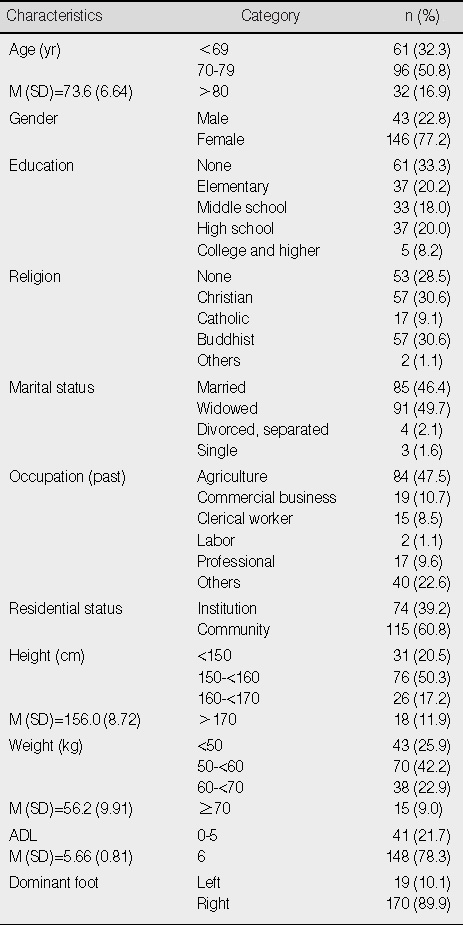
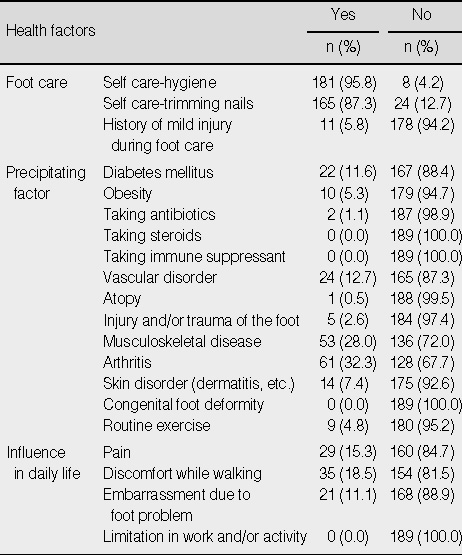
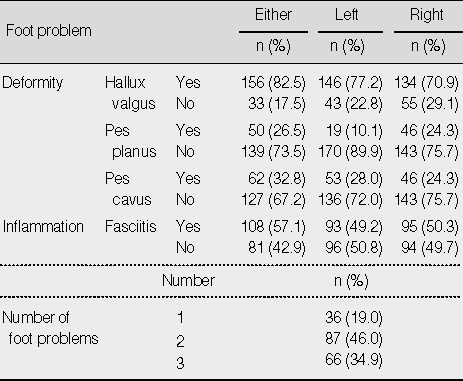
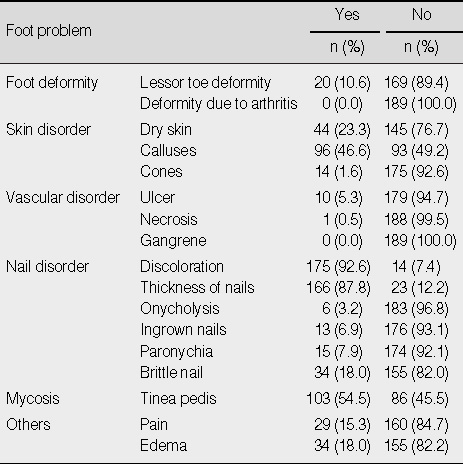
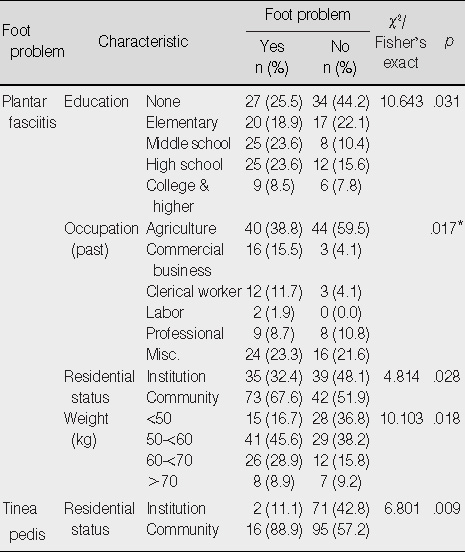

 Cite
Cite

